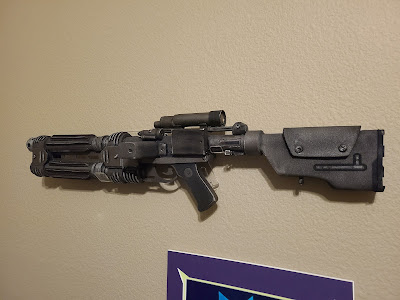I haven't written in a long time, and thought I'd do some quick posts of small projects I've worked on. The first is for a number of small projects I've completed for the Oculus (now Meta) Quest VR headset.
Like many people, my family got our first Quest 2 during the pandemic as a way to "get out" more during lockdown. To this day, I still use my Quest 3 fairly often, sometimes playing for a whole afternoon on the weekend when I'm hooked on a particular new game. During such long play sessions, opportunities to improve the experience presented themselves, leading to a few quick projects.
3D-Printed Back Weight
The first quick project was a way to help balance out the headset to make it more comfortable. While there are a number of great after-market head straps to adjust pressure points and fit around the head, the headset still tends to be front-heavy, which I found would give me a neck ache after hours of continuous play.
While some people use external battery packs strapped to the back of the headstrap, I like to play plugged in, and created a curved, hollow 3d-printed back-weight which I filled with copper slugs.
Staying Charged when Playing
When playing plugged-in, the choice of cable and charger are critically important. In order to play continuously, the Quest must communicate with a smart-charger and coax it into a higher-voltage fast charging mode instead of the USB default of 5 volts. Otherwise, the battery will drain faster than it can charge and will die after a few hours. To do this, one must have a USB-C charger capable of fast-charging, and exclusively use USB-C cables and connectors along the way. This is because USB-C connectors and fast-charge cables have extra wires used for voltage negotiation, while old-style USB connectors do not.
Since a lot of chargers and cables lie when they claim to support fast-charging, spend an extra $10 for an inline USB-C Inline Voltage Meter to verify the charging current and voltage (hint: get one with the male connector on a pigtail, as ones sticking directly out of the device easily break off). Here, we see a Quest 3 fast-charging at 12 volts instead of only five.

Also invest in short right-angle usb-c extension cable which you can attach to your head strap and leave permanently attached to the headset. This will save wear and tear on the delicate USB-C connector, and act as safety disconnect mechanism when accidentally stepping on, or otherwise snagging the cable.
USB-C Rotary Charging Cable Connector
An unfortunate side effect of playing while plugged in -- especially with shooting or fighting games -- is getting the cable twisted all up. While I've tried a number of magnetic swivel connectors, these tend to come apart too easily from the weight of the hanging cable, and none have supported the extra wires needed for fast charging.
To solve this, I came across slip-ring connectors, electrical components which can maintain an electrical connection to a rotating device. They use sliding brushes to keep connections intact across a built-in rotating shaft. This probably makes them too electrically noisy for data, but seemed ideal for power transfer. I spliced one into a short USB-C extension cable, being sure to connect power, ground, SBU, and CC lines, creating a handy adapter that automatically unwinds any twists in the line while I play.
Golf Club Controller Extension
Recently, I've found myself taking a liking to a number of VR sports games for sports I've shown relatively little interest pursuing in real life. Perhaps that's the point of VR: taking in experiences that are too expensive, intimidating, dangerous, or simply too much of a hassle to partake in otherwise.
One such game is
Golf 5 for Quest, which I've found to be realistic and fun. The one thing I wanted, however, was to have an accessory that extended the controller to give a place for my back hand for a more natural grip and swing. There are a lot of existing "golf" controller accessories for Quest, but they generally fall into two categories:
- A fairly long golf-style club in which you attach the controller to its head
- Arms that extend the bottom of the controller primarily for Gorilla Tag but might be useful for golf too.
I didn't really want to have to attach my controller to something long and be swinging it around the room. Not only do I hit enough stuff already with the controller alone, but pressing buttons to activate menus and such would suddenly become a pain. The arm extensions seemed more like what I wanted, but none would work without removing the controller grips I already owned, nor would they feel much like a golf club handle.
This was a perfect excuse for me to use the
Mole 3D Scanner I'd purchased about a year earlier as a gift to myself. I used it to scan my controller handle with its silicone grip on, and build a snug adapter cup I could 3D print.
The cup fits over the existing grip, making it quick and effortless to add or remove at will. With the addition at the bottom of some threaded rod, nuts and a genuine golf club grip to slide over the rod, I finally got the simple extension I wanted.



























